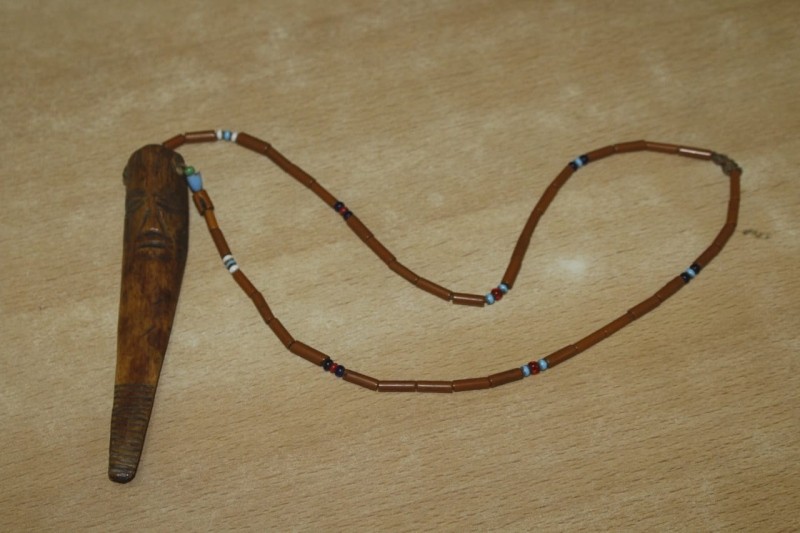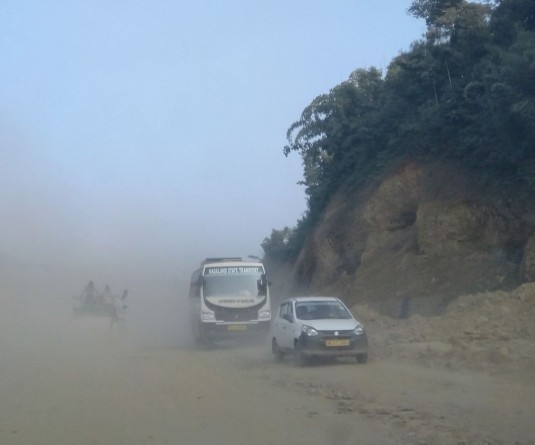The Naga necklace which was received at the State Museum, Kohima on November 5.

Ketholeno Neihu
Kohima | December 7
Nagas have long been subjects of many anthropological studies across the globe and it has been a trend for tourists or scholars to visit Nagaland and take back tribal artifacts or ‘souvenirs’ from their visit.
However, in a very startling occurrence, a parcel from the United States of America containing a tribal necklace along with an unsettling note arrived at the lone State Museum in Kohima last month, almost three months after it was mailed on August 6.
The necklace, presumed to belong to the Konyak Naga tribes reached the State Museum, Department of Art and Culture, Kohima on November 4 last from California with a hope of appeasing the ‘spirits’ in the necklace. The box also contained a handwritten note.
The sender wrote that the returned necklace was bought in 2012 from an antique shop in Nagaland.
“When I returned to the US and looked at this necklace, I felt the spirits in the necklace wanted to return to their land. I had promised these spirits I would return them, however life never brought me back to India or Nagaland,” the note read.
The Department of Art & Culture’s Assistant Director, C Rongsen Pongener attested that the colour patterns of the beaded necklace belonged to the Konyak Naga tribe; more so the ‘animal bone’ with human face carving stringed to the necklace was “authentic” and estimated to be about 60-70 years old.
Not the first time
While this is the most recent case, according to the department officials, similar cases of returning artifacts and archives in the past, have been rare and for different reasons.
For instance, Dr Gordon P Means, a professor at McMaster University in Hamilton in Ontario, Canada who took great interest in the political history of Nagaland back in the years, returned a huge collection of books, papers and audio visual materials through Achilla I Erdican, a recipient of the Governor’s Award, in March 2012.
Before he died in August 12, 2010, Dr Means had requested Erdican to locate ‘a good and reliable depository’ to safeguard his priceless collection. The collection from 1832-2010 contained 538 articles/items/books/video/movie tapes/prompt cards/ audio cassette/magazines etc., of Naga history, art, polity, brief historical account of Nagaland, photographs, newspaper clippings on Nagaland, scrapbook and other important historical accounts.
The collection is now housed at the Department of Art and Culture’s State archives.
Similarly, artifacts belonging to ETD Lambert who served as SDO in Mokokchung from 1933 to 1935 were returned some years back. The collection which is displayed in the State Museum include a bronze bust of Nihu Angami (Naga interpreter), a shoulder bag, warrior’s choker, decorated armlets, apron decorated with cowries, coronet, sash, ear ornament worn by men, ceremonial apron, shin guard, chest ornament, scabbard with belt, ornamental apron and shawl.
As per the department officials, it was initially left surprised; however the sender could not be contacted owing to the lack of proper contact details.
‘Honour the spirits and ancestors’
In the meantime, The Morung Express after making several attempts found the person’s social media handle. Exchanging messages online, the sender, a woman by the name Colleen Choi, recalled that it was in November 2012 that she bought the necklace from “a little shop with a lot of vintage/antique jewelry.”
Narrating why the particular piece caught her attention, Choi stated, “I was a jewelry designer back then and loved handmade crafts. It was my first time in India so I didn't know what to expect.” She also added that the purpose of visit during the odd season was to visit and work with artisans.
Describing Nagaland, Choi who is also an artist said, “Nagaland was beautiful. I love the land, the green (green meaning how green the nature is!); the people were warm and eager to share their stories.”
“Since I didn't have a contact in Nagaland, I looked at Google maps Kohima and saw there was a museum (I didn't know there was a museum before). I thought if I sent it there, it would have the best chance of reaching Nagaland and to someone who would know where the necklace came from and what to do," she said during the exchange with this newspaper.
"I sent it with a lot of prayers in the hope that it will find its way home," Choi shared, while adding that she did not expect that anyone would contact her.
In the note that accompanied the necklace, Choi wrote, “I hope whoever opens this knows the best place to keep the necklace and honour the spirits and ancestors.”
As of now, the department is making plans to exhibit the necklace in the State Museum after proper documentation and formalities are met.






